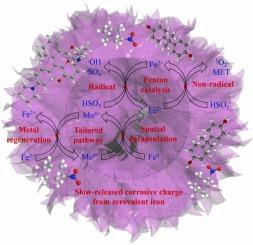Slow-released corrosive charge of zerovalent iron rendered superior Fenton-like catalysis: the tailored electron generation, transfer and utilization derived from spatial MoS2 encapsulation
IF 11.3
1区 环境科学与生态学
Q1 ENGINEERING, ENVIRONMENTAL
引用次数: 0
Abstract
Nano zerovalent iron (nZVI) has attracted great interest for the heterogeneous Fenton-like catalysis in environmental remediation due to its high capacity and low cost. However, toxicity and pollution risks arising from the rapid chemical corrosion in the oxygenated aqueous medium largely limit its more practical applications. In this study, the two-dimensionally defective MoS2 was introduced as the key spatial protector to tailor the electron generation, transfer pathway and utilization efficiency of corrosive charge released from the chemical corrosion of nZVI in aqueous medium during reactions. We rationally designed and controllably prepared the nZVI@MoS2 hybrid, in which MoS2 spatially encapsulated nZVI to form the core-shell structure. Fenton-like catalysis on nZVI@MoS2 produced reactive species to decompose refractory pollutants. Inner nZVI core transferred electrons to PMS through outer MoS2 shell to activate PMS. Moreover, the MoS2 shell promoted the Fe(II)/Fe(III) redox-cycling on nZVI and slowed down chemical corrosion of metallic core for superior and sustainable catalysis. Quenching and electron paramagnetic resonance tests indicated the involved hydroxyl radical, sulfate radical, superoxide radical and singlet oxygen with good reusability. Our work provided a new strategy to refine the environmental potential of nZVI benchmark with high industrial importance by two-dimensional transition metal sulfides for the superior environmental Fenton-like catalysis.

零价铁缓慢释放的腐蚀电荷具有优异的类芬顿催化作用:由MoS2空间封装产生的定制电子生成、转移和利用
纳米零价铁(nZVI)因其高容量和低成本的特点,在环境修复中引起了广泛的关注。然而,在含氧水介质中快速化学腐蚀产生的毒性和污染风险在很大程度上限制了其更实际的应用。在本研究中,引入二维缺陷MoS2作为关键的空间保护器,来调整反应过程中nZVI化学腐蚀释放的腐蚀电荷的电子生成、传递途径和利用效率。我们合理设计并可控制备了nZVI@MoS2杂化材料,其中MoS2在空间上包裹nZVI形成核壳结构。在nZVI@MoS2上进行类芬顿催化,产生反应物质分解难降解污染物。内nZVI核通过外MoS2壳层将电子转移到PMS,激活PMS。此外,MoS2壳层促进了Fe(II)/Fe(III)在nZVI上的氧化还原循环,减缓了金属芯的化学腐蚀,具有优异的催化效果和可持续性。淬火和电子顺磁共振实验表明,所含羟基自由基、硫酸盐自由基、超氧自由基和单线态氧具有良好的可重复使用性。我们的工作为利用二维过渡金属硫化物改善具有重要工业意义的nZVI基准的环境潜力提供了一种新的策略,用于优越的环境类芬顿催化。
本文章由计算机程序翻译,如有差异,请以英文原文为准。
求助全文
约1分钟内获得全文
求助全文
来源期刊

Journal of Hazardous Materials
工程技术-工程:环境
CiteScore
25.40
自引率
5.90%
发文量
3059
审稿时长
58 days
期刊介绍:
The Journal of Hazardous Materials serves as a global platform for promoting cutting-edge research in the field of Environmental Science and Engineering. Our publication features a wide range of articles, including full-length research papers, review articles, and perspectives, with the aim of enhancing our understanding of the dangers and risks associated with various materials concerning public health and the environment. It is important to note that the term "environmental contaminants" refers specifically to substances that pose hazardous effects through contamination, while excluding those that do not have such impacts on the environment or human health. Moreover, we emphasize the distinction between wastes and hazardous materials in order to provide further clarity on the scope of the journal. We have a keen interest in exploring specific compounds and microbial agents that have adverse effects on the environment.
 求助内容:
求助内容: 应助结果提醒方式:
应助结果提醒方式:


